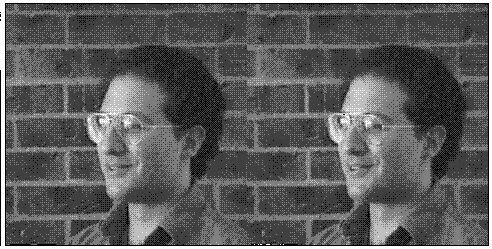The WTN function returns a multi-dimensional discrete wavelet transform of the input array A. The transform is based on a Daubechies wavelet filter.
WTN is based on the routine wtn described in section 13.10 of Numerical Recipes in C: The Art of Scientific Computing (Second Edition), published by Cambridge University Press, and is used by permission.
Syntax
Result = WTN( A, Coef [, /COLUMN] [, /DOUBLE] [, /INVERSE] [, /OVERWRITE] )
Return Value
Returns an output array of the same dimensions as A, containing the discrete wavelet transform over each dimension.
Arguments
A
The input vector or array. The dimensions of A must all be powers of 2.
Note: If WTN is complex then only the real part is used for the computation.
Coef
An integer that specifies the number of wavelet filter coefficients. The allowed values are 4, 12, or 20. When Coef is 4, the daub4() function (see Numerical Recipes, section 13.10) is used. When Coef is 12 or 20, pwt() is called, preceded by pwtset() (see Numerical Recipes, section 13.10).
Keywords
COLUMN
Set this keyword if the input array A is in column-major format (composed of column vectors) rather than in row-major format (composed of row vectors).
DOUBLE
Set this keyword to force the computation to be done in double-precision arithmetic.
INVERSE
If the INVERSE keyword is set, the inverse transform is computed. By default, WTN performs the forward wavelet transform.
OVERWRITE
Set the OVERWRITE keyword to perform the transform “in place.” The result overwrites the original contents of the array.
Examples
This example demonstrates the use of IDL’s discrete wavelet transform and sparse array storage format to compress and store an 8-bit gray-scale digital image. First, an image selected from the people.dat data file is transformed into its wavelet representation and written to a separate data file using the WRITEU procedure.
If you are viewing this topic from within the IDL Workbench, you can click on each code block in turn to execute the example.
coeffs = 12 & thres = 10.0
OPENR, 1, FILEPATH('people.dat', SUBDIR = ['examples','data'])
images = ASSOC(1, BYTARR(192, 192, /NOZERO))
image_1 = images[0]
CLOSE, 1
pwr = 256
image_1 = CONGRID(image_1, pwr, pwr, /CUBIC)
wtn_image = WTN(image_1, coeffs)
OPENW, 1, 'original.dat'
WRITEU, 1, wtn_image
status = FSTAT(1)
CLOSE, 1
PRINT, 'Size of the file is ', status.size, ' bytes.'
Next, the transformed image is converted, using the SPRSIN function, to row-indexed sparse storage format retaining only elements with an absolute magnitude greater than or equal to a specified threshold. The sparse image is written to a data file using the WRITE_SPR procedure.
sprs_image = SPRSIN(wtn_image, THRES = thres)
WRITE_SPR, sprs_image, 'sparse.dat'
OPENR, 1, 'sparse.dat'
status = FSTAT(1)
CLOSE, 1
PRINT, 'Size of the compressed file is ', status.size, ' bytes.'
PRINT, 'Percentage of elements under threshold: ',$
100.*N_ELEMENTS(WHERE(ABS(wtn_image) LT thres, $
count)) / N_ELEMENTS(image_1)
Finally, the transformed image is reconstructed from the storage file and displayed alongside the original.
sprs_image = READ_SPR('sparse.dat')
wtn_image = FULSTR(sprs_image)
image_2 = WTN(wtn_image, COEFFS, /INVERSE)
WINDOW, 1, XSIZE = pwr*2, YSIZE = pwr, $
TITLE = 'Wavelet Image Compression and File I/O'
TV, image_1, 0, 0
TV, image_2, pwr - 1, 0
PRINT, 'The image on the right is reconstructed from:', $
100.0 - (100.* count/N_ELEMENTS(image_1)),$
'% of original image data.'
IDL Output
Size of the file is 262144 bytes.
Size of the compressed file is 69600 bytes.
Percentage of elements under threshold: 87.0331
The image on the right is reconstructed from: 12.9669% of original image data.
The sparse array contains only 13% of the elements contained in the original array. The following figure is created from this example. The image on the left is the original 256 by 256 image. The image on the right was compressed by the above process and was reconstructed from 13% of the original data. The size of the compressed image’s data file is 26.6% of the size of the original image’s data file. Note that due to limitations in the printing process, differences between the images may not be as evident as they would be on a high-resolution printer or monitor. The following shows the original image (left) and image reconstructed from 13% of the data (right).

Version History
See Also
FFT